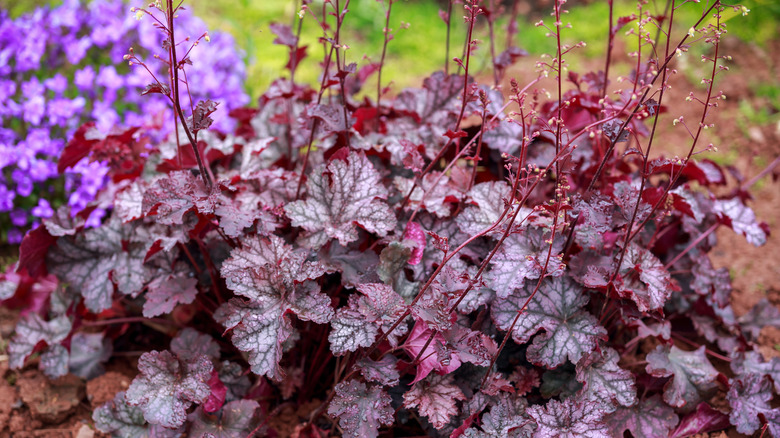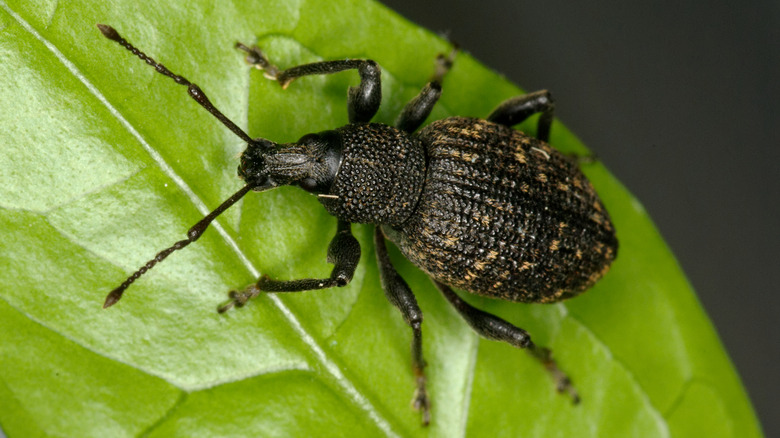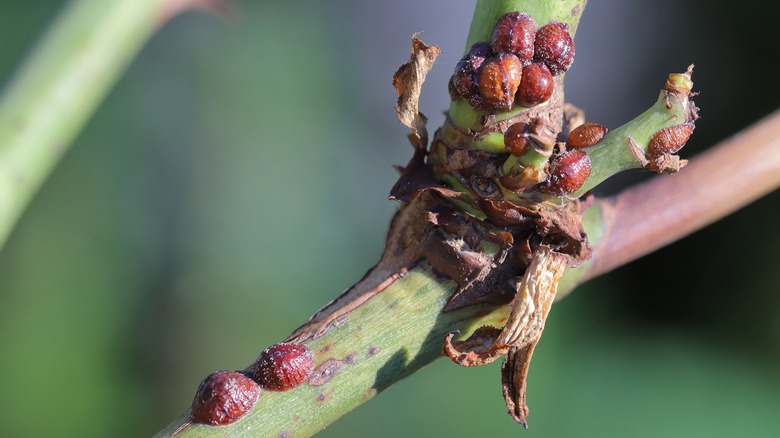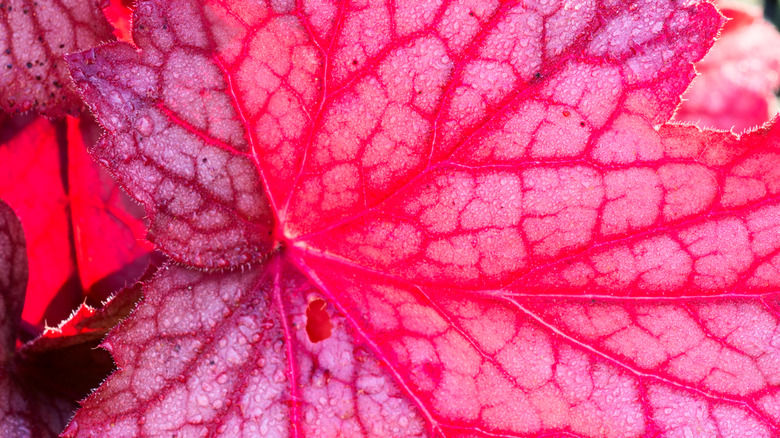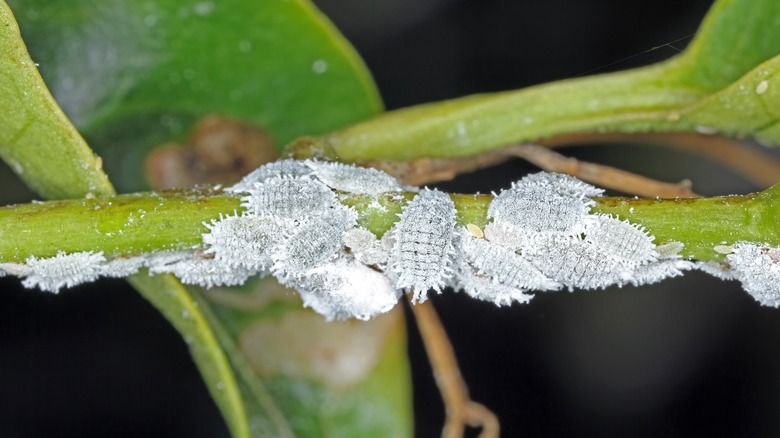Coral Bell Flowers: Common Pests To Be Wary Of & Tips To Eliminate Them
Coral bells, also known as heucheras, are bursting with vibrant foliage and sprightly bell-shaped flowers, and they are among the best plants to keep your garden looking full on a budget. Aside from their good looks, they are pretty tough cookies and don't ask for much care. But as hardy as these flowers are, they are not invincible to pests, with scale insects, mealybugs, and black vine weevils topping the list. Each has an insatiable appetite to turn lush leaves into lacy remnants and robust blooms into wilted memories. The damage inflicted by these pests is not only a visual blight upon your garden's aesthetics. Leave the problem unchecked and the vibrance of your coral bells will get siphoned away right before your eyes.
Some pests go straight for the plant's lifelines, chomping on the roots. You might not even clock what's happening until your plants start dying. As these marauders feast and grow their families, your coral bells are left to suffer from stunted growth and reduced vigor, and will no longer blossom. Coral bell flower pests might sound like a bit of a horror story for your garden. Understand the risk and take advantage of pest control solutions, including hot water spray and alcohol-soaked cotton swabs, so your floral plants won't have to miss a beat. Preemptive measures, including cleaning the garden for debris and introducing predatory insects, can ensure your coral bells remain vibrant and thriving.
Black vine weevils
Black vine weevils are a common pest of collar bell flowers. They are not exactly big — about a ⅜ inch long — but they leave a mark. They sport a short snout and a blackish-brown coat with a rough texture. Black vine weevils are bad news for your collar bells, right from their early stages. Their larvae are legless grubs that always feed on the roots of coral bells like there's no tomorrow, munching away and causing all sorts of drama underground. Meanwhile, the adults sneak out at night and feast on the leaves, carving out notches as they go.
Despite having wings, adult black vine weevils can't fly. If you've found any, simply shake them off of the infected plant. For chemical control, a pyrethroid or bifenthrin-laced insecticide is recommended. The optimal application of these chemicals is May to July, spaced at three-week intervals. Mind the pollinators while you're at it. Now, about black vine weevil larvae. If your plants look a bit sad and wilting or you can pull them out with a gentle tug, it's a sign of trouble underneath: that means they have been feasting on the roots. Winning against these underground foes with a good soil drench of parasitic nematodes applied according to package directions.
Scale insects
Another pest with a penchant for coral bells, scale are tiny critters armored in what looks like a fish scale. Often appearing as oval or round bumps on leaves and stems, these little bugs come in various species and colors (white, gray, or brown). Now, catching these invaders in the act is a bit of a mission because they are small, and their wax coat blends right in with the plant parts. When sucking sap from plants, they excrete honeydew – not the fruit, but a sugary waste that fosters the growth of sooty mold and covers the coral bell leaves in a dark mess that can stop photosynthesis. This could lead to your coral bells' leaves yellowing or dropping prematurely, or even the branches dying.
To get rid of scale on coral bells, a strong blast of water and a gentle scrubbing brush can strip those invaders of their armor, setting them up for dehydration or predation. A wipe-down with soapy water or alcohol-drenched cotton swabs can suffice for indoor coral bells. If the scale is in their crawler stage, a horticultural oil might just do the trick as well. For major infestations, play surgeon — cut down the heavily infected plant parts and discard them in the garbage bin, not the compost. Introduce natural predators like parasitic wasps, flies, and ladybugs to eat scale. Try to steer clear of synthetic pesticides — these could take out the beneficial insects.
Foliar nematodes
Foliar nematodes take up residence in the stems and foliage of your beloved collar bells, unlike their notorious relative, the root-knot nematode. These hungry invaders are pretty stealthy, being only around ¹⁄₂₅ of an inch in length. Their voracious appetite is aided by their needle-like mouthpart. Before you know it, they sneak into the leaf through stomates and feast on the inner cells. Often, you'll notice lesions or odd spots between the leaf veins — a telltale sign of those sneaky nematodes. What starts as soggy-looking blotches turn into a brown, crispy mess that crumble, leaving the leaves ragged.
And it's not just about the looks. Foliar nematodes can stunt the growth of young plants or prevent flowering of your full-grown coral bells. Regarding treatment, there are no chemicals approved for residential use. Unfortunately, your best move is to uproot the infected plants and bag them up for the trash. Don't forget to burn any infested plant debris. Any tool used in the operation should be sterilized with 70% alcohol or 10% bleach to prevent those pesky nematodes from spreading elsewhere. To prevent nematodes in the future, consider switching to drip irrigation to minimize splash-induced spread. Space out your collar bells, too — rain can be an accomplice in the transmission of foliar nematodes.
Mealybugs
The last of the pests to look out for on coral bell flowers are mealybugs: small, soft-bodied insects that can be spotted when in large populations, thanks to their waxy, cotton-like coating. They tend to congregate in clusters in hard-to-see areas of the plant such as leaf axils, under leaves, and at stem joints. Their feeding frenzy, aided by their hair-like mouthparts, can leave your coral bells weak and stunted. Before you know it, the leaves yellow, defoliate, wilt, and eventually drop. The sugary substance mealybugs secrete, called honeydew, doesn't help either. It's a breeding ground for sooty mold, which, like scale, blocks sunlight and limits photosynthesis — a plant's lifeline.
There are many kinds of mealybugs. Citrus mealybugs can inject a toxin into flowers, causing growth malfunction. Root-feeding ground mealybugs could cause above-ground symptoms like stunting, wilting, and flower decline. Speaking of saying goodbye to mealybugs, a strong jet of warm water could work for minor infestations. For spot treatment, wipe mealybug insects and eggs with an alcohol-drenched cotton swab. Other options include horticultural oils, neem oil, and insecticidal soaps. If you've got a severe infestation, trim out the heavily affected plant parts— but ensure it won't ruin the plant's appearance or structure. And for those unsalvageable plants or the root-infested ones, it's best to uproot and discard them. You can attempt biological control of mealybugs by buying ladybugs. Try two to eight per plant.
